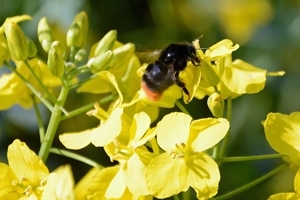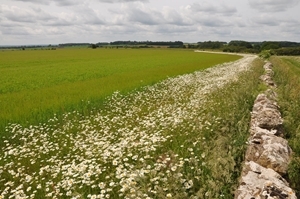Key points
- Flower seed mixes planted on farms that are performing pollinator-friendly management are known to be beneficial to bumblebees, but their effect on other wild bees is not known.
- Increasing the number of flower species on a farm led to an increased number of bee species.
- However, no difference was found in number of solitary bee species between farms performing pollinator-friendly management compared to control farms.
- A low proportion of solitary bees visit flowers sown for pollinator support.
- Adjustments to flower mixes may be beneficial for other wild bees.
Background
 The number of wild bees, and the area over which they live and thrive has been dropping in recent decades, due in large part because of changes to agricultural practices. Agri-environment schemes (AESs) have been developed to promote the planting of flower-rich seed mixes to benefit bees and other insects on farmland.
The number of wild bees, and the area over which they live and thrive has been dropping in recent decades, due in large part because of changes to agricultural practices. Agri-environment schemes (AESs) have been developed to promote the planting of flower-rich seed mixes to benefit bees and other insects on farmland.
These AESs were developed with the needs of bumblebees in mind, but in Britain bumblebees make up only ~10% of the total number of bee species. It has been shown that these flower-rich habitats are helpful to bumblebee populations1, but the effect on other wild bee species was not known.
What they did
Examined the effect of flower-rich habitat created under higher-level stewardship AESs for other wild bee species.
Bees were observed foraging on areas that were planted with flower seed mixes (sown plants), compared to areas on other farms that had no particular flower-rich management. Many of the species contained in these mixes are also found growing wild on farms, but much less commonly.
Surveys detailed which bee species were seen, which plants they visited and the purpose of the visit (for pollen or nectar). Pollen analysis was performed to show what proportion of pollen gathered by bees came from species that were sown for AESs.
What they found
105 species of bee were recorded, including the honey bee, 15 species of bumblebee, 72 species of solitary bee and 17 species of parasitic bee.
As the proportion of flowers within farmland vegetation increased, so did the proportion of pollen-foraging visits to those flowers by solitary bees. As the number of different flowering plant species on a farm increased, so did the number of bee species on that farm, and number of pollen-foraging visits.
There was no difference between the total number of bee and flower species on higher-level AES farms compared to control areas, but there were significantly more flowers on farms doing pollinator-friendly management.
At most only 46% of solitary bee species were observed visiting sown plants for pollen, and only 23% of pollen collected by solitary bees came from sown plants – the majority was from wild plants and flowers. The authors estimate that only 34% of solitary bee species use sown plants to a meaningful level. For more information on the diet of solitary bees collected in the same study area, see Wood et al., 2016.
What does this mean?
 Sowing flower-rich habitat does increase usage of those plants by solitary bees as well as bumblebees, but only a low proportion of solitary species visit this flower-rich habitat. Flower seed mixes have been designed with bumblebees in mind, and are beneficial to those species, however the number of other wild bee species that benefit from sown flowers is limited. Many of these collect pollen from farmland crops such as oilseed rape (and are important pollinators for them), but as these crops are often treated, this can increase their exposure to agricultural chemicals such as pesticides. Increasing the range of flowering plants included in seed mixes used for pollinator-friendly management in higher-level AESs may benefit a wider range of bee species and contribute to maintaining biodiversity. This will form the basis of a new study starting in autumn 2017.
Sowing flower-rich habitat does increase usage of those plants by solitary bees as well as bumblebees, but only a low proportion of solitary species visit this flower-rich habitat. Flower seed mixes have been designed with bumblebees in mind, and are beneficial to those species, however the number of other wild bee species that benefit from sown flowers is limited. Many of these collect pollen from farmland crops such as oilseed rape (and are important pollinators for them), but as these crops are often treated, this can increase their exposure to agricultural chemicals such as pesticides. Increasing the range of flowering plants included in seed mixes used for pollinator-friendly management in higher-level AESs may benefit a wider range of bee species and contribute to maintaining biodiversity. This will form the basis of a new study starting in autumn 2017.
Read the original abstract
Wood, T.J. et al (2017). Providing foraging resources for solitary bees on farmland: current schemes for pollinators benefit a limited suite of species. Journal of Applied Ecology, 54: 323-333.
References
1 Wood, T.J., Holland, J.M., Hughes, W.O.H., & Goulson, D. (2015). Targeted agri-environment schemes significantly improve the population size of common farmland bumblebee species. Molecular Ecology, 24: 1668-1680.
 Does this page interest you?
Does this page interest you?
If the answer is yes, sign up for our FREE weekly newsletter and get all the latest GWCT research news, event invites and offers delivered straight to your inbox.
Sign up FREE to the Weekly GWCT Newsletter >